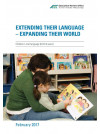Research evidence shows early in a child’s life is a critical time in terms of the rapid language development that takes place, particularly in the first two to three years.
This evaluation investigated how effectively young children’s oral language learning and development were supported in their early years of education.
ERO asked early learning services and schools what they are doing in response to children’s oral language learning and development, including concerns about and needs of particular children? The findings are based on the analysis of data gathered from 167 early learning services and 104 schools
Key Results
Key findings: early learning services
In order to support oral language learning and development, leaders and teachers in early learning services need to know how children’s oral language develops, recognise the fundamental ways the curriculum can promote rich oral language learning and use deliberate teaching strategies.
Professional and pedagogical leadership was critical in building the capability and capacity of teachers to promote and support children’s oral language learning and development. In the services that were strongly focused on supporting children’s learning:
> teachers had in-depth knowledge of every child and a shared understanding of, and expectations for, their oral language learning and development
> leaders and teachers worked in partnership with parents and whänau, and with external agencies and specialist support where necessary
> their curriculum was highly supportive of children’s oral language learning and development
> evaluation, inquiry and monitoring processes were driven by the need to promote and support children’s oral language learning and development.
Improvements were needed in many early learning services to support oral language learning and development. These included:
> leadership capability to support teachers to design and implement a curriculum that:
− gives priority to oral language and recognises oral language as an integral part of early literacy learning
− is based on a shared and explicit understanding of children’s oral language development
− includes deliberate teaching strategies to support all learners, making children’s oral language learning and development visible in assessment information
> evaluating the impact of practices and strategies on improving oral language outcomes
> capitalising on ‘home languages’ as a foundation for other language learning
> being prompt and proactive where concerns are identified about children’s oral language learning and development.
Key findings: the first three years of primary school
Similarly, there were common themes in the way the most effective primary schools supported students’ oral language learning and development. These included:
> transition-to-school programmes through which information was shared about oral language learning and development (including any strengths and needs)
> both formal assessment and informal daily monitoring of oral language progress of all learners, particularly in the early months after starting school
> explicit oral language learning expectations were developed as part of school-wide progressions
> daily literacy programmes with a strong oral language focus
> identifying students needing additional support early and responding appropriately.
Improvements were needed in many schools to support oral learning and development. These included:
> giving greater attention to the oral language learning of new entrants (within a rich curriculum)
> developing formal expectations for monitoring oral language progress or development across Years 1 to 3 and beyond, across all key learning areas
> taking a formalised approach to identifying students’ oral language strengths (including capabilities in languages other than English), needs and concerns, rather than relying on informal observation and ‘gut feeling’
> systematically planning for interventions, where particular concerns or needs for oral language learning and development are identified
> teachers building on the advantage linguistically-diverse learners bring to language learning
> building and strengthening teacher capability to support oral language teaching and learning.

